
Dogs have for centuries been a common subject in art throughout Europe, particularly of course in hunting scenes, but the dog as household pet and ladies' companion, indoor or outdoor, made increasingly frequent appearances in the 18th and 19th centuries, and the fashion spread to Russia. The toy spaniel who accompanies the ladies in Khrutsky's park landscape is an intrusion from another genre, an almost routine detail in many Russian paintings in which women, children or families are portrayed. In some cases the dog turns out to be an intrusion from a much older pictorial tradition. An exploration of this tradition leads surprisingly ... 
You can click on any of the dogs on this page to see a larger image of the paintings and drawings from which they are taken, except for the snuff-box lid, which is almost full-size.
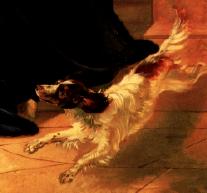
 The spaniel leaping down a flight of steps on the right is from Karl Briullov's Portrait of the Shishmarev Sisters, dating from the same year as Khrutsky's painting (1839). Unlike Khrutsky, Briullov was trained to the highest European standards, and was skilled in the depiction of animals. The difference between their spaniels is immediately apparent. The dog on the left, another toy spaniel, is from an anonymous mid-nineteenth-century painting of The Study in the Country House of Count Dmitrii Tolstoy, a somewhat naive work in which the dog has its place, along with the furniture, like the elements of an icon.
The spaniel leaping down a flight of steps on the right is from Karl Briullov's Portrait of the Shishmarev Sisters, dating from the same year as Khrutsky's painting (1839). Unlike Khrutsky, Briullov was trained to the highest European standards, and was skilled in the depiction of animals. The difference between their spaniels is immediately apparent. The dog on the left, another toy spaniel, is from an anonymous mid-nineteenth-century painting of The Study in the Country House of Count Dmitrii Tolstoy, a somewhat naive work in which the dog has its place, along with the furniture, like the elements of an icon.

 The dog on the right, occupying its mistress' lap, is from a cynical drawing by Pavel Fedotov entitled A Lady of Importance (1848-50), while
the dog holding a lady's hand on the left is a pug, another favorite toy breed (called in Russian a mops, or mopsik, or mos'ka), from another drawing by Fedotov, with a title that could be translated as Pug to the Rescue. Fedotov was given to satirizing the pretensions of the Russian gentry of his day, and he clearly saw ownership of lap-dogs as one of those pretensions.
The dog on the right, occupying its mistress' lap, is from a cynical drawing by Pavel Fedotov entitled A Lady of Importance (1848-50), while
the dog holding a lady's hand on the left is a pug, another favorite toy breed (called in Russian a mops, or mopsik, or mos'ka), from another drawing by Fedotov, with a title that could be translated as Pug to the Rescue. Fedotov was given to satirizing the pretensions of the Russian gentry of his day, and he clearly saw ownership of lap-dogs as one of those pretensions.
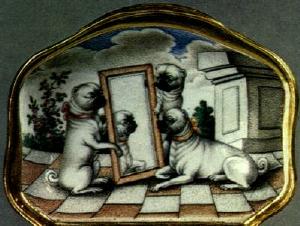 To judge by the china snuff-box lid on the right, in the eyes of at least one Russian artist pugs could be as vain as their owners. In any event, dogs were often included in eighteenth and nineteenth-century portraits of children. Three of the four examples below are from anonymous portraits, and they are a fascinating example of the persistence of older traditions in Europeanized Russian art. Anonymous family portraits are most often from the provinces, the work of serf painters, sometimes apprenticed in a monastic icon-painting school, sometimes sent to a local painter for some lessons, and only rarely allowed to obtain a professional level of training and pursue a more or less independent career as a painter. Many such portraits by the servants of the rich, including some that are signed, have a naive quality and show traces of the depictive conventions of iconography or folk-art. This doesn't necessarily mean that painters from this background were unskilled or unsophisticated: they saw the world with Russian, not European eyes, and they were trained in something other than contemporary European techniques for representing it.
To judge by the china snuff-box lid on the right, in the eyes of at least one Russian artist pugs could be as vain as their owners. In any event, dogs were often included in eighteenth and nineteenth-century portraits of children. Three of the four examples below are from anonymous portraits, and they are a fascinating example of the persistence of older traditions in Europeanized Russian art. Anonymous family portraits are most often from the provinces, the work of serf painters, sometimes apprenticed in a monastic icon-painting school, sometimes sent to a local painter for some lessons, and only rarely allowed to obtain a professional level of training and pursue a more or less independent career as a painter. Many such portraits by the servants of the rich, including some that are signed, have a naive quality and show traces of the depictive conventions of iconography or folk-art. This doesn't necessarily mean that painters from this background were unskilled or unsophisticated: they saw the world with Russian, not European eyes, and they were trained in something other than contemporary European techniques for representing it.
Animals are difficult to depict realistically, and Khrutsky's spaniel is not the only dog in post-Petrine Russian painting that falls short by European professional standards. However, this is not simply a matter of lack of skill. The two dogs below, left and center, have some oddly familiar details: small backward-pointing ears, short noses turned up at the tip, a prominent pointed tongue (left) or sickle-shaped teeth (center).
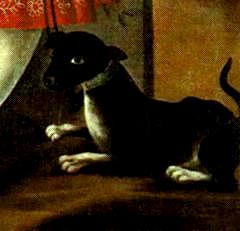
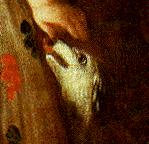 On the right is a dog licking the hand of a girl in another anonymous portrait, this time from the mid-eighteenth century. Once again, the tongue is not broad and flat, as is anatomically correct: it is the conventional curved, pointed tongue of the fabulous beast at the mouth of hell. On the left is the dog from Pavel Kolendas' Portrait of Nicholas Temerin (1844). This animal also shows traces of the icon in its artificial posture and its lack of contact with its surroundings: it isn't lying on the floor, it's simply included in the picture in the appropriate place.
On the right is a dog licking the hand of a girl in another anonymous portrait, this time from the mid-eighteenth century. Once again, the tongue is not broad and flat, as is anatomically correct: it is the conventional curved, pointed tongue of the fabulous beast at the mouth of hell. On the left is the dog from Pavel Kolendas' Portrait of Nicholas Temerin (1844). This animal also shows traces of the icon in its artificial posture and its lack of contact with its surroundings: it isn't lying on the floor, it's simply included in the picture in the appropriate place.The fashion of including pet dogs in portraiture and genre painting made its way to Russia, but from the middle of the eighteenth to the middle of the nineteenth century there were occasional signs that it was a foreign intrusion. An indication of the intrusion on the social level is the treatment of pet dogs by satirical painters of Russian life. More interesting are the evident signs that the domestic dog was a challenge to some Russian painters on the pictorial level, prompting them to draw on a set image that was both within their technical repertoire, and a familiar item in the Russian visual environment. 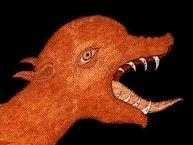 It is a testament to the endurance of the popular images of Russian iconography that the red creature compared with the dogs above was painted as late as the mid-nineteenth century - after the canine portraits that betray signs of the tradition he represents. Perhaps only in Russia could the pet dog of a daughter or son of the gentry have characteristics that link it with the iconic guardians of hell and the mythical beasts of Classical antiquity. Click on the Continue button at the the foot of the page to explore this further. At least until the second quarter of the nineteenth century, occasional reversion to the graphic norms of the icon in European-style studio painting can certainly be thought of as a national idiosyncracy in post-Petrine Russian art.
It is a testament to the endurance of the popular images of Russian iconography that the red creature compared with the dogs above was painted as late as the mid-nineteenth century - after the canine portraits that betray signs of the tradition he represents. Perhaps only in Russia could the pet dog of a daughter or son of the gentry have characteristics that link it with the iconic guardians of hell and the mythical beasts of Classical antiquity. Click on the Continue button at the the foot of the page to explore this further. At least until the second quarter of the nineteenth century, occasional reversion to the graphic norms of the icon in European-style studio painting can certainly be thought of as a national idiosyncracy in post-Petrine Russian art.



